
The Cha Cha Cha is a Latin-American dance with 4-beat-count, originally from Cuba.
The dance is a further development of mambo and was introduced by bandleader Enrique Jorrin in 1953. It is considered to have gotten it's name after the pattern of the steps: 2 slow steps followed by 3 quick steps (go-go-cha-cha-cha). The dance came to USA through Mexico and from there on to Europe, where it became very popular. So How did all of this come about?
Ballroom instructors who attended Mambo clubs, especially the Palladium where Mambo stars like Cuban Pete performed virtually every weekend, were invaluable to the standardization and codification of the first Mambo dance steps. Borrowing the idea from the East Coast Swing, the single, double, and triple steps were added between the rock steps of the Mambo as the musicians played one of three main tempos; the Bolero, the Son, or the Guaracha. All three tempos were called Mambo and it was not long until dance studios were selling the new Mambo dance to eager students. Eventually, the triple-step (Guaracha) Mambo basic was renamed the Cha-Cha-Cha.
Fast Facts
- The Cha Cha is a cheeky, lively and flirtatious dance. It has a catch-me-if-you-can atmosphere, and is light and bubbly.
- It has a distinctive syncopation where 5 steps are danced to four beats hence the 'One, two, three, cha cha cha' description.
- The dance is originally from Cuba.
- The Cha Cha was first called the "Triple Mambo".

| Cha Cha Timetable | |||
| Next course | Where | Cost | Register online |
| Coming soon |
Plesno Mesto Mercator Centre Šiška |
TBA | REGISTER HERE |
| Coming soon |
Plesno Mesto Mercator Centre Šiška |
TBA | REGISTER HERE |
Distinctive Moves
- Triple steps (chassez) and rock steps are the basic components of the Cha Cha. Since the Cha Cha is derived from the Rumba and Mambo dances, Cuban Motion is an important aspect of this dance as well as maintaining quick compact steps. Cuban Motion describes the hip motion resulting from the alternate bending and straightening of the knees.
- The dancers should synchronize movements, working in parallel with each other.
- The New Yorker is a characteristic move, where a dancer steps across their partner and checks to change direction.
